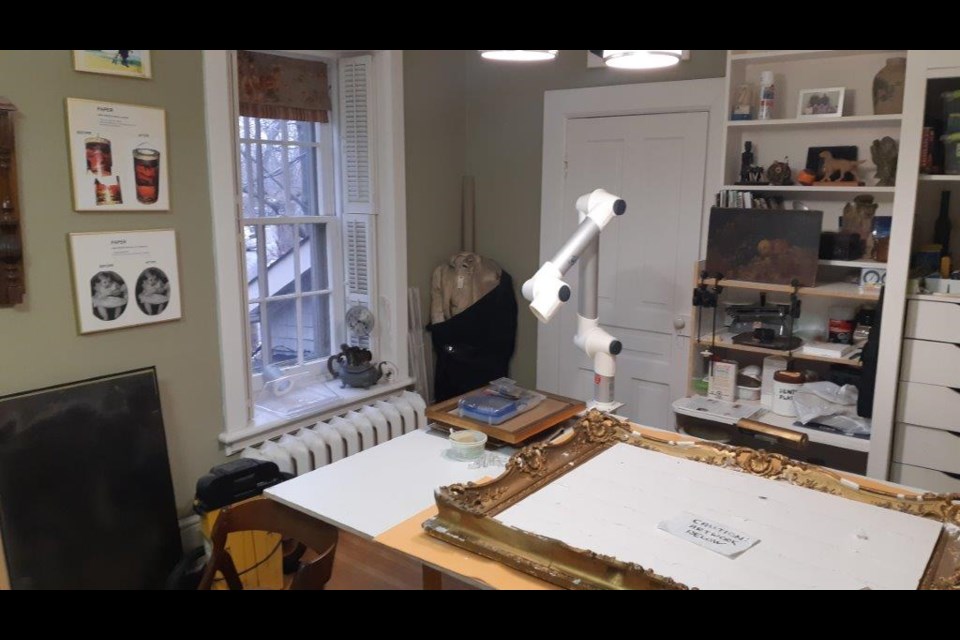One day the phone rang in our office. On the other end was a lady with a problem: her treasured teapot had a nasty chip, and she hoped to find a ceramics expert to repair it. She had asked around town and been referred to us, and while we don’t have a teapot-repair department, we were equally interested to know where she could find help to restore a treasured object.
That’s how I met LloyOsburn. Lloy is a local conservator who specializes in paper and textiles, but through her network of colleagues, the teapot was repaired. I was still curious to know more about art conservation, from someone in our own neighbourhood. I visited herstudio, in a heritage building on Woolwich (not far from the Wooly pub) to get a look behind the scenes.
KW: How does one become a conservator?
LO: I began my careerworking as a laboratory technician in the Veterinary College at the University of Guelph. But since childhood, I had been an avid antique collector and accomplished artist. At a certain point, it was like a light coming on between the art, antiques and lab work. So at 38, I went back to school.
I studied at Sir Sanford Fleming College, where I specialized in paper and textiles, with internships at the McMichael Gallery in Kleinburg, the Royal British Columbia Museum in Victoria, and the Canadian Conservation institute.
A summer romance in the Yukon led to a fifteen-year stint in Whitehorse, where I was Paper Conservator at the newlyconstructed Yukon Archives in Whitehorse, along with contracts at the local museums, galleries, and heritage institutions.
KW: Now you’re in Guelph, with your own business. Who comes knocking at your door, and what do they need help with?
LO: Yes, I moved back to my hometown of Guelph in 2007 and opened Artful Restorations. Who are my clients? Antique dealers, and insurance, fire and flood damage companies who subcontract out the art restoration to me. Sometimes, a family member will come to save a work with sentimental value. I remember one woman who was recently widowed and lost a son in a car crash. She had been given a painting by her daughter, but the painting fell off the wall and was damaged. Many joyful tears were shed when I was finished with the repairs!
KW: Would you give me a tour of your tools and projects?
(See photo gallery)
KW: What myths about protecting and restoring art can you debunk?
(Read more details at guelpharts.ca)
1) I can store art in my basement or attic.
Basements are damp, which leads to mould – a health hazard with some permanent effects on art.
Attics are dry and hot, which makes work brittle and fragile, like dry skin.
- If I put it away, it’s probably safe.
Tears often occur from poor handling, folding, and rolling. Prevent damage by restricting handling and placing the works in suitable housing: acid free folders and boxes. These can be purchased through a conservator. Conservators are available for consultations regarding the restoration, handling, storage of works of art and artifacts.
- My damaged artwork is ruined forever.
The number one misconception is that conservation is impossible. Many damaged artifacts can be brought back by a skilled conservator.
- It’s too costly to have something restored!
An average job is 3-5 hours and conservators charge approximately $100 per hour. Also, verbal estimates are free if carried out in the studio.
- Sunlight doesn’t harm works of art.
Incorrect! Exposure to sunlight or interior lights can fade artwork, as can brief flashes of intense light.
In short, house your artwork out of direct sunlight, in acid free materials, in a room that provides reasonable cleanliness, temperature and humidity. Store items on a shelf rather than on the floor as water damage can occur from basement flooding, overhead pipes, rain/roof leaks, etc. And it something does go wrong (or even before), contact a conservator!
This Content is made possible by our Sponsor; it is not written by and does not necessarily reflect the views of the editorial staff.

